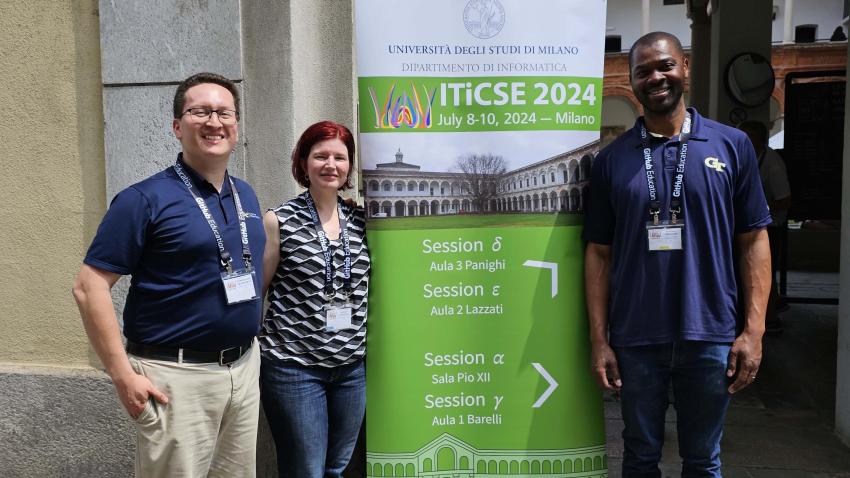
Innovative Video Assignments Could Enhance Learning in Large CS Classes
Better engagement with instructors and improved learning outcomes are on the horizon for university students enrolled in large computing-related survey courses.
Researchers from Georgia Tech’s School of Computing Instruction (SCI) recently presented their study on active learning strategies in large computer science (CS) classes at the 29th Annual ACM Conference on Innovation and Technology in Computer Science Education (ITiCSE).
The annual conference gathers global educators and researchers to discuss advancements and innovations in computing education.
In their paper, SCI Lecturer Pedro Guillermo Feijóo-García, Lecturer Nimisha Roy, and Chair Olufisayo Omojokun explore using student-created instructional videos to foster engagement and improve learning outcomes in large, introductory software design and engineering (SWE) courses.

Addressing the Challenge of Active Learning in Large Classes
Promoting active learning in large computing courses, often with hundreds of students, poses significant challenges. The larger the class, the harder it is to effectively support students and foster a deep understanding of complex concepts.
Recognizing these challenges, the researchers proposed a novel pedagogical strategy: leveraging student-created instructional videos as a medium to facilitate learning by teaching.
The Study
Implemented in two large introductory SWE classes during Fall 2023, the strategy engaged 448 college CS students in a unique take-home activity. The researchers integrated the activity into the midterm exam, which included both open-ended questions on SWE concepts and a diagramming question.
First, students were tasked with creating an instructional video to explain their responses to the exam questions. This process required them to articulate their understanding of SWE concepts clearly and concisely, effectively teaching the material to their peers.
After creating their videos, students participated in an anonymized peer-review process, providing feedback on their classmates' explanations.
“I think the experience helped students reinforce their understanding of the course material and, more importantly, learn how to learn,” Guillermo Feijóo-García said.
“This activity is a perfect opportunity for students to build communication skills and the confidence required to present their ideas. Sometimes, we forget that CS as a discipline goes beyond the computer, especially nowadays when technology actively and organically acts in society.”
Enhanced Perceived Learning and Engagement
Researchers surveyed the students, asking how much they learned from this approach. The results were promising. Most students felt that they learned a lot from making the videos and reviewing their peers’ work.
Significantly, 80.4% of the students agreed with the statement, "Creating my video helped me learn the course content." These results indicate that the assignment was particularly effective in helping students internalize and understand SWE concepts.
The findings from this study suggest that student-created instructional videos can be a powerful tool in promoting active learning and enhancing student engagement in large computing courses and beyond.
“Students love active learning and gain much from activities that challenge their thought processes and openly reflect on how they think about their solutions,” Guillermo Feijóo-García said.
The strategy allows students to assume the role of teachers, consolidating their knowledge while fostering a collaborative learning environment though the peer review process.
Guillermo Feijóo-García says this active learning format could be used or adapted in other courses and levels beyond their CS-2340 Objects and Design course. The team has received positive feedback from the broader CS education community and peers from national and international institutions interested in following up with their approach.
“The strategy suggests that educators can better engage with their student audience when dealing with large class formats,” said Guillermo Feijóo-García.
“Also, with large language models nowadays, this kind of strategy can pose exciting learning opportunities that can challenge students to learn significantly and appreciate what they learn during their processes.”
ITiCSE 2024 was held in Milan, Italy, July 8-10.
As computing revolutionizes research in science and engineering disciplines and drives industry innovation, Georgia Tech leads the way, ranking as a top-tier destination for undergraduate computer science (CS) education. Read more about the college's commitment:… https://t.co/9e5udNwuuD pic.twitter.com/MZ6KU9gpF3
— Georgia Tech Computing (@gtcomputing) September 24, 2024


